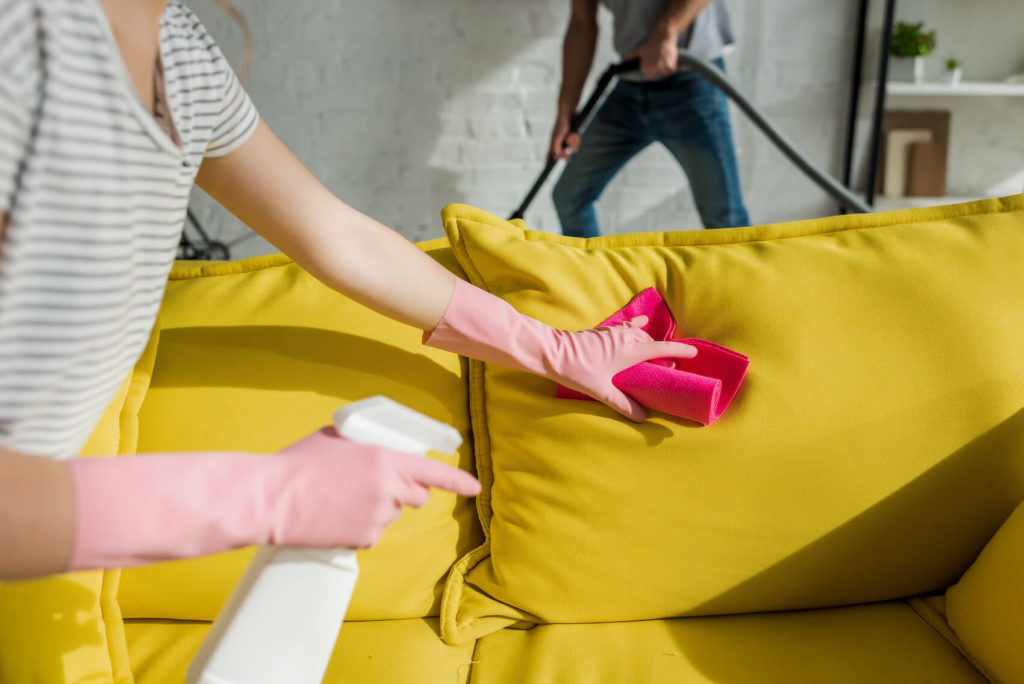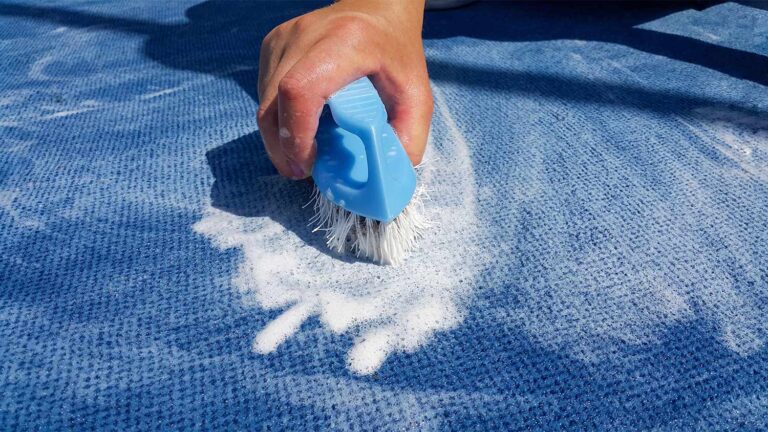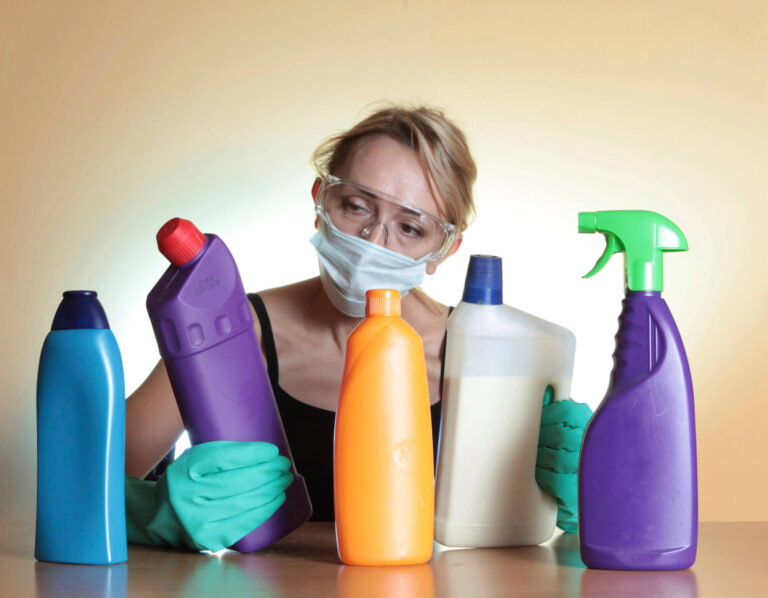
Before you start, double-check the manufacturer’s cleaning instructions. When you buy a couch, it comes with care tags that show you which cleaning methods and materials are best for your sofa. These are found underneath the cushions of your couch.
W – You can use water-based cleaners;
S – Solvent-based cleaning chemicals should be used;
W/S – Either water-based or solvent-based cleaners can be utilised;
X– Don’t use any cleaning chemicals. Only use a vacuum or brush only for the fabric.
After knowing which specific cleaning code to be used on your couch, it is essential to know the fabric type you are dealing with. You can use the guide below for cloth, microfiber, and leather couches.
How to Clean Fabric Couch
How to Clean a Suede Couch
For both microsuede and natural suede couches, it is best that spills and stains be dealt with quickly before they set in. Beyond that, they will look beautiful with a good cleaning twice a year. Your couch should look excellent for years to come if you maintain it adequately regularly.
- Use a hand vacuum to collect any dust, debris, or pet hair left on your cushions. It’s advisable to do this for at least a month.
- If liquid spills on your suede couch, dab the area with a clean, dry cloth to absorb as much liquid as possible. To prevent pressing the liquid more profound into the fabric, lift straight up after dabbing. Allow the area to dry completely before deciding whether or not further action is required.
- If you have stains on your microsuede couch, white vinegar or rubbing alcohol is the most acceptable way to remove them. On a clean terry towel, pour a small amount of each liquid. Avoid saturating the material with too much liquid since this will make the stain worse. Gently massage the stain in a crisscross pattern using a moist terry cloth.
- Use gentle motions to avoid damaging the nap of your couch. It would be best to inspect a small sofa section for potential damage or discoloration before using any cleaning solution. Consult the manufacturer’s care instructions to find out which type of cleanser is best for your couch.
- Use a suede eraser (typically meant for shoes) or even a pencil eraser to gently rub away dry spots that you can’t remove with the approaches above. If that doesn’t work, use a soft nail file or sandpaper. Brush the couch again after that to smooth the fibers back into place.
How to Clean a Velvet Couch
- Vacuum regularly. It’s recommendable to use a soft brush to remove away dirt and debris.
- If a drink was spilled on the couch, wipe the area with a clean, dry absorbent towel right away.
- Using the edge of a dull knife, scrape away any solids, then wipe any excess moisture.
- You should then mix several drops of dishwashing liquid with two glasses of warm water to treat any stain. Produce suds with a whisk. Wring out a damp microfiber towel after dipping it in freshwater. Gently dab the discolored area with a wet cloth dipped in only the suds. As the stain is transferred, keep moving to a clean part of the fabric. Test any cleaning agents in a hidden spot to make sure there are no color changes to the velvet.
- Allow for air drying of the affected region. Lift matted fibers with your hands or with a steamer.
How to Clean a Polyester Couch
- Decipher the care label to find the right cleaner for your couch. Vacuum your couch to remove debris and dust before applying the cleaner. An upholstery brush can also be used. Also, make sure to get into the nooks and crannies of your couch.
- Spray the cleaner on your couch or the area where the stain is. Concentrate on the stained or soiled areas, gently wiping or rubbing the stains until they disappear. Most sofa cleaners don’t require rinsing – just dab them into the cloth. However, if your cleaner requires rinsing, follow the instructions on the packaging.
- Take a soft-bristled brush and gently rub it against the fabric after the cleaning solution has dried if your couch is stiff after cleaning. This method should give your material a soft, fluffy texture.
How to Clean a Microfiber Couch
If your couch either has a W or W/S cleaning tag: use water-based cleaners for it, and here’s what you should do.
- Vacuum the area properly and pay attention to stitched seams that collect crumbs or dust.
- In a bucket or large basin, pour four cups of warm water. Add a quarter cup of liquid dishwashing soap to the mix. To make a lot of soapy suds, use a whisk. A second bucket should be filled with ordinary water.
- Dip the scrubbing brush or sponge into the soap suds only rather than the water. Begin at the top of the cushion or the back or arms of the couch, evenly distribute the suds and scrub thoroughly. Dirty suds will not leak onto already cleaned areas if you start at the top and work your way down. As you repeat the processes with fresh soap suds, rinse the brush or sponge in clean water and ensure you make it as dry as you can.
- After you’ve cleared an area, moisten a microfiber cleaning cloth with plain water and wipe it down. Allow for total air drying of the fabric. Fluff any matted fibers with a vacuum or upholstery brush.
If your couch has an S cleaning tag: use solvent-based cleaners or dry cleaner solvent for it, and here’s what you should do:
- Vacuum every part of the couch.
- Fill a spray bottle halfway with rubbing alcohol and lightly spritz the fabric, starting at the top of a cushion or portion. Read the directions on the label and follow them if you’re using a commercial product.
- Remove filth using a sponge or soft-bristled brush while the fabric is damp with rubbing alcohol. Before cleaning, rinse the sponge in plain water to eliminate any soil and squeeze out as much moisture as possible.
- Allow the upholstery to air dry before vacuuming or brushing any matted fibers with an upholstery brush.
If your microfiber couch has grease stains, sprinkle it with cornstarch and rub it in with an old toothbrush. You should wait at least an hour to sit before vacuuming. If necessary, repeat the process. The cornstarch will absorb the grease. Clean the area with soap suds or rubbing alcohol on a spot basis.
If chewing gum is the issue, place ice cubes in a tight plastic bag on top of the chewing gum to harden it. Break the hardened gum away using a dull knife or your fingernail. Slowly work your way around the gum, refreezing it as needed. Use soap suds or rubbing alcohol to get rid of any leftover stains.
How to Clean Leather Couch
When you’re cleaning a leather couch, here are some significant tips you might find helpful for different stains.
For general spills and messes:
- Using a vacuum cleaner, remove dust, debris, and loose particles from the leather sofa’s surface.
- In a bowl, combine equal parts of water and vinegar to make a cleaning solution. If the solution separates, re-mix it a few times and wipe it down with a soft cloth.
- Start by dampening the cloth (but not wetting it) and wiping the unclean portions of the leather. Wipe any damp areas you see with a damp cloth once you’ve wiped down the troublesome places.
For Ink Stains
- Using a cotton ball, apply to rubbing alcohol.
- Gently dab the ink stain with the cotton ball until it begins to lift (do not rub). Repeat with a fresh cotton ball and more rubbing alcohol.
- Using a soft cloth, pat the area dry.
For Grease and Oil Stains
- Collect as much grease as possible with paper towels.
- Over the stain, sprinkle a pinch of baking soda. You should allow the baking soda to sit for a few hours or until all of the oil has been absorbed.
- Wipe the residue away using a gentle cloth.
- Start by dampening the cloth (but not wetting it) and wiping the unclean portions of the leather.
For Coffee Stains
- To remove the coffee stain as possible, blot it well with a paper towel or a clean rag. Instead of something else, the paper towel absorbs the coffee better.
- Scrub the stain lightly with a moist microfiber cloth and a few drops of liquid soap to make it foam. Allow 3-5 minutes for the soap to work.
- Wipe away any soapy residue with a clean damp cloth. If there are any coffee stains on the seams, continue the foam treatment until the color is no longer visible.
Here’s a link to a more detailed article on how to clean your leather sofa.
How to Get Rid of the Couch Smell
There’s no need to dedicate a day to buying cleaners to remove the foul smell on your couch. You can use these regular household items to get rid of the couch smell.
White Vinegar
- Fill a spray bottle halfway with white vinegar and start spraying cushions and armrests. If you’re worried about the vinegar changing the upholstery, spritz a tiny bit on your couch in a hidden spot and leave it overnight.
- Hold the bottle several inches away from the fabric when spraying the white vinegar solution so that just a light mist reaches the fibers. If you hold the bottle too close to your face, you’ll get a wet mark and a strong vinegar odor.
Baking Soda
- Carefully sprinkle baking soda over cushions, crevices, and specially stained places. Allow an hour or so for the baking soda to work, then vacuum up the remnants.
- If the stink continues, vacuum the sofa again and sprinkle baking soda on the cushions, pillows, and even the rug underneath to deodorize the couch and combat residual odors. Volatile chemicals that cause odor will cling to the baking soda’s crystal-like formations, neutralizing the stench and removing it from your couch.
Activated Charcoal
Activated charcoal is a more effective adsorbent and odor remover than baking soda, and it can handle a broader range of particles. This highly cleaned charcoal dust, on the other hand, isn’t the most refined item to use on your furniture because it can stain. Instead, get activated charcoal freshener bags like these and place them in the corners of your furniture to help minimize odors.
How to Remove Urine Odor From Your Couch
To remove urine odor from your couch, follow these 4 steps:
- If the mess is recent, soak up as much excess urine from your couch.
- Combine one cup of distilled white vinegar with four cups of water. Squeeze out any extra vinegar with a towel dipped in the solution. Scrub the vinegar into the damaged region with a scrubbing motion to let the vinegar seep into the upholstery. If the location is difficult to reach, spritz it with vinegar and scrub it afterward.
- Allow several minutes for the vinegar solution to rest on the sofa to neutralize the urine odor. After that, you should then mix a cup of baking soda with a few drops of your favorite essential fragrance. Allow the baking soda to lie on the filthy area of the couch overnight. Baking soda should assist in removing any remaining urine and moisture, and mixing it with essential oil should help refresh the sofa even more.
- Vacuum it up and repeat the process if you still smell the urine.
Taking care of your couches is easier said than done. It is impossible to avoid a foul odor and difficult-to-remove stains. If you need help cleaning your couches by a professional, give the professional upholstery cleaners a call! If you’re interested in booking an upholstery cleaning service, don’t hesitate to visit our appointment page or call us at 01 503 7011 to get yourself a free quote!


